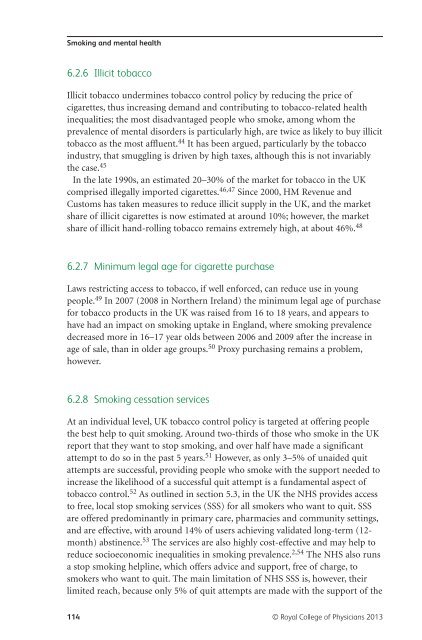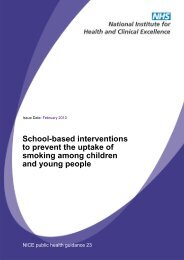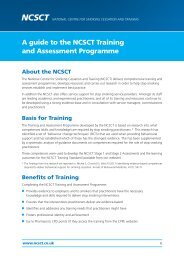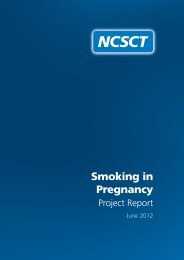Smoking and mental health - NCSCT
Smoking and mental health - NCSCT
Smoking and mental health - NCSCT
You also want an ePaper? Increase the reach of your titles
YUMPU automatically turns print PDFs into web optimized ePapers that Google loves.
<strong>Smoking</strong> <strong>and</strong> <strong>mental</strong> <strong>health</strong><br />
6.2.6 Illicit tobacco<br />
Illicit tobacco undermines tobacco control policy by reducing the price of<br />
cigarettes, thus increasing dem<strong>and</strong> <strong>and</strong> contributing to tobacco-related <strong>health</strong><br />
inequalities; the most disadvantaged people who smoke, among whom the<br />
prevalence of <strong>mental</strong> disorders is particularly high, are twice as likely to buy illicit<br />
tobacco as the most affluent. 44 It has been argued, particularly by the tobacco<br />
industry, that smuggling is driven by high taxes, although this is not invariably<br />
the case. 45<br />
In the late 1990s, an estimated 20–30% of the market for tobacco in the UK<br />
comprised illegally imported cigarettes. 46,47 Since 2000, HM Revenue <strong>and</strong><br />
Customs has taken measures to reduce illicit supply in the UK, <strong>and</strong> the market<br />
share of illicit cigarettes is now estimated at around 10%; however, the market<br />
share of illicit h<strong>and</strong>-rolling tobacco remains extremely high, at about 46%. 48<br />
6.2.7 Minimum legal age for cigarette purchase<br />
Laws restricting access to tobacco, if well enforced, can reduce use in young<br />
people. 49 In 2007 (2008 in Northern Irel<strong>and</strong>) the minimum legal age of purchase<br />
for tobacco products in the UK was raised from 16 to 18 years, <strong>and</strong> appears to<br />
have had an impact on smoking uptake in Engl<strong>and</strong>, where smoking prevalence<br />
decreased more in 16–17 year olds between 2006 <strong>and</strong> 2009 after the increase in<br />
age of sale, than in older age groups. 50 Proxy purchasing remains a problem,<br />
however.<br />
6.2.8 <strong>Smoking</strong> cessation services<br />
At an individual level, UK tobacco control policy is targeted at offering people<br />
the best help to quit smoking. Around two-thirds of those who smoke in the UK<br />
report that they want to stop smoking, <strong>and</strong> over half have made a significant<br />
attempt to do so in the past 5 years. 51 However, as only 3–5% of unaided quit<br />
attempts are successful, providing people who smoke with the support needed to<br />
increase the likelihood of a successful quit attempt is a funda<strong>mental</strong> aspect of<br />
tobacco control. 52 As outlined in section 5.3, in the UK the NHS provides access<br />
to free, local stop smoking services (SSS) for all smokers who want to quit. SSS<br />
are offered predominantly in primary care, pharmacies <strong>and</strong> community settings,<br />
<strong>and</strong> are effective, with around 14% of users achieving validated long-term (12-<br />
month) abstinence. 53 The services are also highly cost-effective <strong>and</strong> may help to<br />
reduce socioeconomic inequalities in smoking prevalence. 2,54 The NHS also runs<br />
a stop smoking helpline, which offers advice <strong>and</strong> support, free of charge, to<br />
smokers who want to quit. The main limitation of NHS SSS is, however, their<br />
limited reach, because only 5% of quit attempts are made with the support of the<br />
114 © Royal College of Physicians 2013














